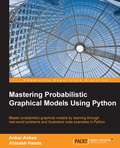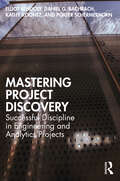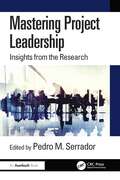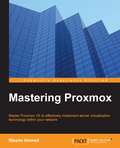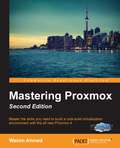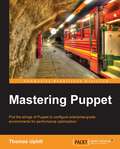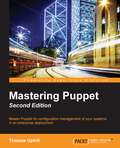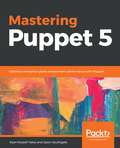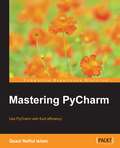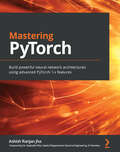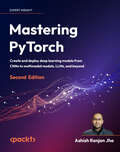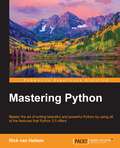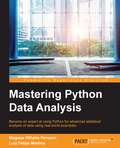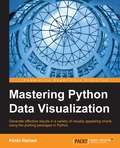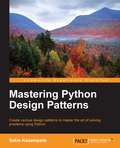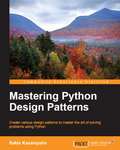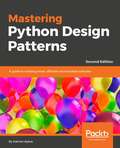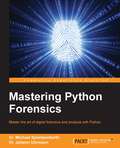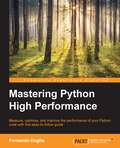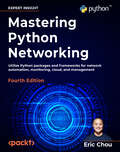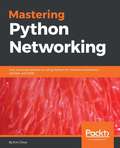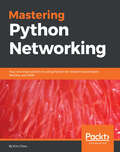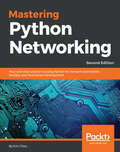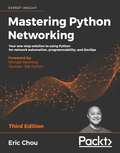- Table View
- List View
Mastering Probabilistic Graphical Models Using Python
by Ankur Ankan Abinash PandaIf you are a researcher or a machine learning enthusiast, or are working in the data science field and have a basic idea of Bayesian learning or probabilistic graphical models, this book will help you to understand the details of graphical models and use them in your data science problems.
Mastering Project Discovery: Successful Discipline in Engineering and Analytics Projects
by Elliot Bendoly Daniel Bachrach Kathy Koontz Porter SchermerhornIntroducing a comprehensive approach to invigorate project leadership, this book provides a framework – the OUtCoMES Cycle – for developing, managing, advancing, and optimizing engineering and analytics projects.All too often, issues of moral hazard and completion bias prevent engineering and analytics managers and team leaders from asking the critical question 'What’s the problem?', before committing time, energy, and resources to solve it. This book draws attention to the definition, structuring, option consideration and ultimately the addressing of the right problems, exploring the OUtCoMES Cycle framework that facilitates and energizes systematic thinking, knowledge sharing, and on-the-fly adjustment with an explicit focus on the maximization of value and ROI. Each chapter includes discussions and lessons in analytical and engineering problem identification, problem structuring, iterative problem development (mental and computational) and problem resolution, at least three embedded real-world case studies, and a closing 'Practitioner’s Recap' to contextualize key chapter takeaways.Written by a team of established academic scholars and practicing analysts and engineers, this is an accessible and culture-shifting action guide for instructors interested in training the next generation of project and analytics leaders, students of analytics and engineering, as well as practicing project leaders and principals.
Mastering Project Leadership: Insights from the Research
by Pedro M. SerradorThis is a collection of essays from key researchers in the field of project management who describe what they feel are the most impactful findings from research. In the challenging and competitive world of project management, project managers need all the insight they can get. Leading researchers share what they believe are the most important findings from the research being done today. These cover pressing topics confronting project managers, including hybrid methodologies, schedule overruns, schedule estimation, project efficiency, and managing local stakeholders. Highlights include the following: Jeff Pinto and Kate Davis explore the “Normalization of Deviance” (NoD) phenomenon within various organizational settings, focusing on projects. NoD involves the gradual acceptance of deviant practices, diverging from established norms, and often leading to detrimental outcomes. Francesco Di Maddaloni investigates how local communities’ stakeholders are perceived, identified, and categorized by project managers in major public infrastructure and construction projects (MPIC). His chapter helps project managers to have a better understanding of a more inclusive and holistic approach to engage with a broader range of stakeholders. Lavagnon Ika, Peter Love, and Jeff Pinto suggest that error and bias combine to exact a toll on major projects, offer theoretical insights, and outline practical recommendations for project managers. Jonas Söderlund offers managerial guidelines for leveraging deadlines as powerful tools for generating project success. Pedro M. Serrado looks at empirical studies that link planning quality to project success, emphasizing its importance. He also discusses the downsides of excessive planning, particularly in dynamic environments and research and development projects.
Mastering Proxmox
by Wasim AhmedThis is not an instructional guide, but a practical, scenario-based book which guides you through everything you need to know in a practical manner by letting you build your own cluster. By the end of the book, you will have a fully functional Proxmox cluster setup at your disposal and have the knowledge to replicate virtualization solutions .If you already know what the word "virtualization" means and you are ready to stand out from the crowd equipped with the unique ability to design and implement a rock-solid virtualized network environment using Proxmox, then you have just picked up the only book you will need. Linux system administration experience together with knowledge of networking and virtualization concepts is assumed. This book is also useful if you are already using Proxmox and simply want to master its advanced features.
Mastering Proxmox - Second Edition
by Wasim AhmedThe book targets Linux and system administrators and professionals working in IT teams who would like to design and implement a enterprise-quality virtualized environment using Proxmox.Knowledge of networking and virtualization concepts is assumed.
Mastering Puppet
by Thomas UphillIn Detail Puppet is a configuration management system written for system administrators to manage a large number of systems efficiently and help maintain order. Mastering Puppetdeals with the issues faced in larger deployments such as scaling and duplicate resource definitions. It will show you how to fit Puppet into your organization and keep everyone working. The concepts presented can be adapted to suit any size organization. This book starts with setting up and installing Puppet in your organization and then moves on to implementing version control in Puppet, creating custom modules, and extending your Puppet infrastructure. Finally, you will learn tips and tricks that are useful when troubleshooting Puppet and the best practices to make you a pro. Approach Presented in an easy-to-follow, step-by-step tutorial format and packed with examples, this book will lead you through making the best out of Puppet in an enterprise environment. Who this book is for If you are a system administrator or developer who has used Puppet in production and are looking for ways to easily use Puppet in an enterprise environment, this book is for you. This book assumes an intermediate knowledge of Puppet and is intended for those writing modules or deploying Puppet in an enterprise environment.
Mastering Puppet - Second Edition
by Thomas UphillMaster Puppet for configuration management of your systems in an enterprise deployment About This Book * This book is an advanced guide to using and deploying Puppet 4 in your organization with a special focus on issues faced in larger enterprise deployments * From an experienced author, learn to deal with scaling, performance, and multiple developers with the help of real-world examples * This is the most up-to-date guide on Puppet, and covers the advanced concepts of Puppet 4 Who This Book Is For This book is for those who have intermediate knowledge of Puppet and are looking to deploy it in their environment. Some idea how to write simple modules for configuration management with Puppet is a prerequisite for this book. What You Will Learn * Scale out your Puppet infrastructure using proxying techniques * Automate your code promotion workflow using Git and r10k * Solve real-world problems using public modules from the Puppet Forge * Use Hiera to separate the data of your configuration from the code of your configuration * Write your own custom facts in Ruby * Extend Puppet with your own custom facts, modules, and types * Use exported resources to orchestrate change between machines * Debug a puppetserver using Java techniques In Detail Puppet is a configuration management system and a language. It was written for and by system administrators to manage large numbers of systems efficiently and prevent configuration drifts. Mastering Puppet deals with the issues faced when scaling out Puppet to handle large numbers of nodes. It will show you how to fit Puppet into your enterprise and allow many developers to work on your Puppet code simultaneously. In addition, you will learn to write custom facts and roll your own modules to solve problems. Next, popular options for performing reporting and orchestration tasks will be introduced in this book. Moving over to troubleshooting techniques, which will be very useful. The concepts presented are useful to any size organization. By the end of the book, you will know how to deal with problems of scale and exceptions in your code, automate workflows, and support multiple developers working simultaneously. Style and approach This book is a step-wise guide packed with examples to help you configure complex systems in Puppet.
Mastering Puppet 5: Optimize enterprise-grade environment performance with Puppet
by Ryan Russell-Yates Jason SouthgateLeverage Puppet 5 for medium to large scale enterprise deployment.Key FeaturesUse and deploy Puppet 5, irrespective the size of your organizationScaling, performance improvements, and managing multiple developer requestsTroubleshooting techniques, tips and tricks to make the most of Puppet 5Book DescriptionPuppet is a configuration management system and a language written for and by system administrators to manage a large number of systems efficiently and prevent configuration drift.The core topics this book addresses are Puppet's latest features and mastering Puppet Enterprise. You will begin by writing a new Puppet module, gaining an understanding of the guidelines and style of the Puppet community. Following on from this, you will take advantage of the roles and profiles pattern, and you will learn how to structure your code. Next, you will learn how to extend Puppet and write custom facts, functions, types, and providers in Ruby, and also use the new features of Hiera 5. You will also learn how to configure the new Code Manager component, and how to ensure code is automatically deployed to (multiple) Puppet servers. Next, you will learn how to integrate Puppet with Jenkins and Git to build an effective workflow for multiple teams, and use the new Puppet Tasks feature and the latest Puppet Orchestrator language extensions. Finally, you will learn how to scale and troubleshoot Puppet.By the end of the book, you will be able to deal with problems of scale and exceptions in your code, automate workflows, and support multiple developers working simultaneously.What you will learnSolve problems using modules and the roles and profiles patternExtend Puppet with custom facts, functions, types, and providersUse Hiera 5 and Code Manager/r10k to separate code from dataContinuously integrate your code using Jenkins, Git and automated testingUse exported resources and the new Puppet Orchestration featuresExplore Puppet Discovery features and their useTroubleshoot various parts of the Puppet Enterprise infrastructureScale up and scale out Puppet infrastructure using various techniquesWho this book is forIf you are a system administrator or developer who has used Puppet in production and are looking for ways to easily use Puppet in an enterprise environment, this book is for you. Some knowledge of writing simple configuration management modules would be necessary.
Mastering PyCharm
by Quazi Nafiul IslamUse PyCharm with fluid efficiency to write idiomatic python codeAbout This BookUnderstand how PyCharm works and how you can leverage its strength to develop applications quicklyMaster PyCharm's editor to get a fast workflowFull of examples and illustrations that focus on the practical aspects of using PyCharmWho This Book Is ForIf you know PyCharm but want to understand it better and leverage its more powerful but less obvious tool set, this is the book for you. Serving as a launch pad for those who want to master PyCharm and completely harness its best features, it would be helpful if you were familiar with some of Python's most prominent tools such as virtualenv and Python's popular docstring formats such as reStructuredText and EpyType.What You Will LearnUnderstand the internal workings of the IntelliJ PlatformLeverage PyCharm's powerful search tools, and learn which ones are the best for you and your workflowCustomize PyCharm's enhanced Python interpreter and its inbuilt terminalDevelop web applications quickly and easily with different frameworks such as Flask and DjangoUnderstand how code completion works in PyCharm for Python and JavaScriptMake calls to external tools, and use PyCharm macros to your advantageIn DetailPyCharm is addictive, with powerful and configurable code completion, superb editing tools, top-notch support, diverse plugins, and a vibrant ecosystem to boot. Learning how PyCharm works and maximising the synergy of its powerful tools will help you to rapidly develop applications.From leveraging the power of the editor to understanding PyCharm's internals, this book will give you a comprehensive view of PyCharm and allow you to make your own choices about which workflow and tools are best for you.You will start by getting comfortable with PyCharm and making it look exactly like you want. You can customize the tools and taskbars to suit individual developers' coding styles. You also learn how to assign keyboard shortcuts. You will master debugging by inserting breakpoints, collecting runtime data, and debugging from the console. You will understand how PyCharm works underneath and how plugins such as Codemap, Vim, Bitbucket, Assets compressor, markdown, bash file, shortcut translator, and .gitignore leverage the power of the IntelliJ platform.You will become comfortable using the VCS interface in PyCharm and see the benefits of using it for some simple tasks as well as some more complex tasks such as partial commits using changelists.You will take an in-depth look at the various tools in PyCharm, improving your workflow drastically. Finally, you will deploy powerful PyCharm tools for Django, Flask, GAE, and Pyramid Development, becoming well acquainted with PyCharm's toolset for web development with popular platforms.Packed with insider tricks, this book will help you boost productivity with PyCharm.Style and approachAn easy-to-follow guide with plenty of examples and screenshots. Each topic starts off with the goal of enhancing or changing a part of PyCharm to make it suit your needs.
Mastering PyTorch: Build powerful neural network architectures using advanced PyTorch 1.x features
by Ashish Ranjan Jha Dr. Gopinath PillaiMaster advanced techniques and algorithms for deep learning with PyTorch using real-world examplesKey FeaturesUnderstand how to use PyTorch 1.x to build advanced neural network modelsLearn to perform a wide range of tasks by implementing deep learning algorithms and techniquesGain expertise in domains such as computer vision, NLP, Deep RL, Explainable AI, and much moreBook DescriptionDeep learning is driving the AI revolution, and PyTorch is making it easier than ever before for anyone to build deep learning applications. This PyTorch book will help you uncover expert techniques to get the most out of your data and build complex neural network models. The book starts with a quick overview of PyTorch and explores using convolutional neural network (CNN) architectures for image classification. You'll then work with recurrent neural network (RNN) architectures and transformers for sentiment analysis. As you advance, you'll apply deep learning across different domains, such as music, text, and image generation using generative models and explore the world of generative adversarial networks (GANs). You'll not only build and train your own deep reinforcement learning models in PyTorch but also deploy PyTorch models to production using expert tips and techniques. Finally, you'll get to grips with training large models efficiently in a distributed manner, searching neural architectures effectively with AutoML, and rapidly prototyping models using PyTorch and fast.ai. By the end of this PyTorch book, you'll be able to perform complex deep learning tasks using PyTorch to build smart artificial intelligence models.What you will learnImplement text and music generating models using PyTorchBuild a deep Q-network (DQN) model in PyTorchExport universal PyTorch models using Open Neural Network Exchange (ONNX)Become well-versed with rapid prototyping using PyTorch with fast.aiPerform neural architecture search effectively using AutoMLEasily interpret machine learning (ML) models written in PyTorch using CaptumDesign ResNets, LSTMs, Transformers, and more using PyTorchFind out how to use PyTorch for distributed training using the torch.distributed APIWho this book is forThis book is for data scientists, machine learning researchers, and deep learning practitioners looking to implement advanced deep learning paradigms using PyTorch 1.x. Working knowledge of deep learning with Python programming is required.
Mastering PyTorch: Create and deploy deep learning models from CNNs to multimodal models, LLMs, and beyond
by Ashish Ranjan JhaMaster advanced techniques and algorithms for machine learning with PyTorch using real-world examples Updated for PyTorch 2.x, including integration with Hugging Face, mobile deployment, diffusion models, and graph neural networks Purchase of the print or Kindle book includes a free eBook in PDF formatKey FeaturesUnderstand how to use PyTorch to build advanced neural network modelsGet the best from PyTorch by working with Hugging Face, fastai, PyTorch Lightning, PyTorch Geometric, Flask, and DockerUnlock faster training with multiple GPUs and optimize model deployment using efficient inference frameworksBook DescriptionPyTorch is making it easier than ever before for anyone to build deep learning applications. This PyTorch deep learning book will help you uncover expert techniques to get the most out of your data and build complex neural network models. You’ll build convolutional neural networks for image classification and recurrent neural networks and transformers for sentiment analysis. As you advance, you'll apply deep learning across different domains, such as music, text, and image generation, using generative models, including diffusion models. You'll not only build and train your own deep reinforcement learning models in PyTorch but also learn to optimize model training using multiple CPUs, GPUs, and mixed-precision training. You’ll deploy PyTorch models to production, including mobile devices. Finally, you’ll discover the PyTorch ecosystem and its rich set of libraries. These libraries will add another set of tools to your deep learning toolbelt, teaching you how to use fastai to prototype models and PyTorch Lightning to train models. You’ll discover libraries for AutoML and explainable AI (XAI), create recommendation systems, and build language and vision transformers with Hugging Face. By the end of this book, you'll be able to perform complex deep learning tasks using PyTorch to build smart artificial intelligence models.What you will learnImplement text, vision, and music generation models using PyTorchBuild a deep Q-network (DQN) model in PyTorchDeploy PyTorch models on mobile devices (Android and iOS)Become well versed in rapid prototyping using PyTorch with fastaiPerform neural architecture search effectively using AutoMLEasily interpret machine learning models using CaptumDesign ResNets, LSTMs, and graph neural networks (GNNs)Create language and vision transformer models using Hugging FaceWho this book is forThis deep learning with PyTorch book is for data scientists, machine learning engineers, machine learning researchers, and deep learning practitioners looking to implement advanced deep learning models using PyTorch. This book is ideal for those looking to switch from TensorFlow to PyTorch. Working knowledge of deep learning with Python is required.
Mastering Python
by Rick Van HattemMaster the art of writing beautiful and powerful Python by using all of the features that Python 3.5 offers About This Book * Become familiar with the most important and advanced parts of the Python code style * Learn the trickier aspects of Python and put it in a structured context for deeper understanding of the language * Offers an expert's-eye overview of how these advanced tasks fit together in Python as a whole along with practical examples Who This Book Is For Almost anyone can learn to write working script and create high quality code but they might lack a structured understanding of what it means to be 'Pythonic'. If you are a Python programmer who wants to code efficiently by getting the syntax and usage of a few intricate Python techniques exactly right, this book is for you. What You Will Learn * Create a virtualenv and start a new project * Understand how and when to use the functional programming paradigm * Get familiar with the different ways the decorators can be written in * Understand the power of generators and coroutines without digressing into lambda calculus * Create metaclasses and how it makes working with Python far easier * Generate HTML documentation out of documents and code using Sphinx * Learn how to track and optimize application performance, both memory and cpu * Use the multiprocessing library, not just locally but also across multiple machines * Get a basic understanding of packaging and creating your own libraries/applications In Detail Python is a dynamic programming language. It is known for its high readability and hence it is often the first language learned by new programmers. Python being multi-paradigm, it can be used to achieve the same thing in different ways and it is compatible across different platforms. Even if you find writing Python code easy, writing code that is efficient, easy to maintain, and reuse is not so straightforward. This book is an authoritative guide that will help you learn new advanced methods in a clear and contextualised way. It starts off by creating a project-specific environment using venv, introducing you to different Pythonic syntax and common pitfalls before moving on to cover the functional features in Python. It covers how to create different decorators, generators, and metaclasses. It also introduces you to functools.wraps and coroutines and how they work. Later on you will learn to use asyncio module for asynchronous clients and servers. You will also get familiar with different testing systems such as py.test, doctest, and unittest, and debugging tools such as Python debugger and faulthandler. You will learn to optimize application performance so that it works efficiently across multiple machines and Python versions. Finally, it will teach you how to access C functions with a simple Python call. By the end of the book, you will be able to write more advanced scripts and take on bigger challenges. Style and Approach This book is a comprehensive guide that covers advanced features of the Python language, and communicate them with an authoritative understanding of the underlying rationale for how, when, and why to use them.
Mastering Python Data Analysis
by Luiz Felipe Martins Magnus Vilhelm PerssonBecome an expert at using Python for advanced statistical analysis of data using real-world examples About This Book * Clean, format, and explore data using graphical and numerical summaries * Leverage the IPython environment to efficiently analyze data with Python * Packed with easy-to-follow examples to develop advanced computational skills for the analysis of complex data Who This Book Is For If you are a competent Python developer who wants to take your data analysis skills to the next level by solving complex problems, then this advanced guide is for you. Familiarity with the basics of applying Python libraries to data sets is assumed. What You Will Learn * Read, sort, and map various data into Python and Pandas * Recognise patterns so you can understand and explore data * Use statistical models to discover patterns in data * Review classical statistical inference using Python, Pandas, and SciPy * Detect similarities and differences in data with clustering * Clean your data to make it useful * Work in Jupyter Notebook to produce publication ready figures to be included in reports In Detail Python, a multi-paradigm programming language, has become the language of choice for data scientists for data analysis, visualization, and machine learning. Ever imagined how to become an expert at effectively approaching data analysis problems, solving them, and extracting all of the available information from your data? Well, look no further, this is the book you want! Through this comprehensive guide, you will explore data and present results and conclusions from statistical analysis in a meaningful way. You'll be able to quickly and accurately perform the hands-on sorting, reduction, and subsequent analysis, and fully appreciate how data analysis methods can support business decision-making. You'll start off by learning about the tools available for data analysis in Python and will then explore the statistical models that are used to identify patterns in data. Gradually, you'll move on to review statistical inference using Python, Pandas, and SciPy. After that, we'll focus on performing regression using computational tools and you'll get to understand the problem of identifying clusters in data in an algorithmic way. Finally, we delve into advanced techniques to quantify cause and effect using Bayesian methods and you'll discover how to use Python's tools for supervised machine learning. Style and approach This book takes a step-by-step approach to reading, processing, and analyzing data in Python using various methods and tools. Rich in examples, each topic connects to real-world examples and retrieves data directly online where possible. With this book, you are given the knowledge and tools to explore any data on your own, encouraging a curiosity befitting all data scientists.
Mastering Python Data Visualization
by Kirthi RamanGenerate effective results in a variety of visually appealing charts using the plotting packages in PythonAbout This BookExplore various tools and their strengths while building meaningful representations that can make it easier to understand dataPacked with computational methods and algorithms in diverse fields of scienceWritten in an easy-to-follow categorical style, this book discusses some niche techniques that will make your code easier to work with and reuseWho This Book Is ForIf you are a Python developer who performs data visualization and wants to develop existing knowledge about Python to build analytical results and produce some amazing visual display, then this book is for you. A basic knowledge level and understanding of Python libraries is assumed.What You Will LearnGather, cleanse, access, and map data to a visual frameworkRecognize which visualization method is applicable and learn best practices for data visualizationGet acquainted with reader-driven narratives and author-driven narratives and the principles of perceptionUnderstand why Python is an effective tool to be used for numerical computation much like MATLAB, and explore some interesting data structures that come with itExplore with various visualization choices how Python can be very useful in computation in the field of finance and statisticsGet to know why Python is the second choice after Java, and is used frequently in the field of machine learningCompare Python with other visualization approaches using Julia and a JavaScript-based framework such as D3.jsDiscover how Python can be used in conjunction with NoSQL such as Hive to produce results efficiently in a distributed environmentIn DetailPython has a handful of open source libraries for numerical computations involving optimization, linear algebra, integration, interpolation, and other special functions using array objects, machine learning, data mining, and plotting. Pandas have a productive environment for data analysis. These libraries have a specific purpose and play an important role in the research into diverse domains including economics, finance, biological sciences, social science, health care, and many more. The variety of tools and approaches available within Python community is stunning, and can bolster and enhance visual story experiences.This book offers practical guidance to help you on the journey to effective data visualization. Commencing with a chapter on the data framework, which explains the transformation of data into information and eventually knowledge, this book subsequently covers the complete visualization process using the most popular Python libraries with working examples. You will learn the usage of Numpy, Scipy, IPython, MatPlotLib, Pandas, Patsy, and Scikit-Learn with a focus on generating results that can be visualized in many different ways. Further chapters are aimed at not only showing advanced techniques such as interactive plotting; numerical, graphical linear, and non-linear regression; clustering and classification, but also in helping you understand the aesthetics and best practices of data visualization. The book concludes with interesting examples such as social networks, directed graph examples in real-life, data structures appropriate for these problems, and network analysis.By the end of this book, you will be able to effectively solve a broad set of data analysis problems.Style and approachThe approach of this book is not step by step, but rather categorical. The categories are based on fields such as bioinformatics, statistical and machine learning, financial computation, and linear algebra. This approach is beneficial for the community in many different fields of work and also helps you learn how one approach can make sense across many fields
Mastering Python Design Patterns
by Sakis KasampalisThis book is for Python programmers with an intermediate background and an interest in design patterns implemented in idiomatic Python. Programmers of other languages who are interested in Python can also benefit from this book, but it would be better if they first read some introductory materials that explain how things are done in Python.
Mastering Python Design Patterns
by Sakis Kasampalis<P><P>Create various design patterns to master the art of solving problems using Python <P><P>About This Book <P><P>Simplify design pattern implementation using the power of Python <P><P>Each pattern is accompanied with a real-world example demonstrating its key features <P><P>This is an easy-to-follow guide focusing on the practical aspects of Python design patterns <P><P>Who This Book Is For <P><P>This book is for Python programmers with an intermediate background and an interest in design patterns implemented in idiomatic Python. Programmers of other languages who are interested in Python can also benefit from this book, but it would be better if they first read some introductory materials that explain how things are done in Python. <P><P>What You Will Learn <P><P>Explore Factory Method and Abstract Factory for object creation <P><P>Clone objects using the Prototype pattern <P><P>Make incompatible interfaces compatible using the Adapter pattern <P><P>Secure an interface using the Proxy pattern <P><P>Choose an algorithm dynamically using the Strategy pattern <P><P>Extend an object without subclassing using the Decorator pattern <P><P>Keep the logic decoupled from the UI using the MVC pattern <P><P>In Detail <P><P>Python is an object-oriented, scripting language that is used in wide range of categories. In software engineering, a design pattern is a recommended solution to a software design problem. Although not new, design patterns remain one of the hottest topics in software engineering and they come as a ready reference for software developers to solve the common problems they face at work. <P><P>This book will take you through each and every design pattern explained with the help of real-world examples. The aim of the book is to introduce more low-level detail and concepts on how to write Pythonic code, not just focusing on common solutions as implemented in Java and C++. It includes small sections on troubleshooting, best practices, system architecture, and its design aspects. With the help of this book, you will be able to understand Python design pattern concepts and the framework, as well as issues and their resolution. You'll focus on all 16 design patterns that are used to solve everyday problems.
Mastering Python Design Patterns: A guide to creating smart, efficient, and reusable software, 2nd Edition
by Sakis Kasampalis Kamon AyevaExploit various design patterns to master the art of solving problems using PythonKey FeaturesMaster the application design using the core design patterns and latest features of Python 3.7Learn tricks to solve common design and architectural challengesChoose the right plan to improve your programs and increase their productivityBook DescriptionPython is an object-oriented scripting language that is used in a wide range of categories. In software engineering, a design pattern is an elected solution for solving software design problems. Although they have been around for a while, design patterns remain one of the top topics in software engineering, and are a ready source for software developers to solve the problems they face on a regular basis. This book takes you through a variety of design patterns and explains them with real-world examples. You will get to grips with low-level details and concepts that show you how to write Python code, without focusing on common solutions as enabled in Java and C++. You'll also fnd sections on corrections, best practices, system architecture, and its designing aspects. This book will help you learn the core concepts of design patterns and the way they can be used to resolve software design problems. You'll focus on most of the Gang of Four (GoF) design patterns, which are used to solve everyday problems, and take your skills to the next level with reactive and functional patterns that help you build resilient, scalable, and robust applications. By the end of the book, you'll be able to effciently address commonly faced problems and develop applications, and also be comfortable working on scalable and maintainable projects of any size.What you will learnExplore Factory Method and Abstract Factory for object creationClone objects using the Prototype patternMake incompatible interfaces compatible using the Adapter patternSecure an interface using the Proxy patternChoose an algorithm dynamically using the Strategy patternKeep the logic decoupled from the UI using the MVC patternLeverage the Observer pattern to understand reactive programmingExplore patterns for cloud-native, microservices, and serverless architecturesWho this book is forThis book is for intermediate Python developers. Prior knowledge of design patterns is not required to enjoy this book.
Mastering Python Forensics
by Dr Michael SpreitzenbarthIf you are a network security professional or forensics analyst who wants to gain a deeper understanding of performing forensic analysis with Python, then this book is for you. Some Python experience would be helpful.
Mastering Python High Performance
by Fernando DoglioMeasure, optimize, and improve the performance of your Python code with this easy-to-follow guide About This Book * Master the do's and don'ts of Python performance programming * Learn how to use exiting new tools that will help you improve your scripts * A step-by-step, conceptual guide to teach you how to optimize and fine-tune your critical pieces of code Who This Book Is For If you're a Python developer looking to improve the speed of your scripts or simply wanting to take your skills to the next level, then this book is perfect for you. What You Will Learn * Master code optimization step-by-step and learn how to use different tools * Understand what a profiler is and how to read its output * Interpret visual output from profiling tools and improve the performance of your script * Use Cython to create fast applications using Python and C * Take advantage of PyPy to improve performance of Python code * Optimize number-crunching code with NumPy, Numba, Parakeet, and Pandas In Detail Simply knowing how to code is not enough; on mission-critical pieces of code, every bit of memory and every CPU cycle counts, and knowing how to squish every bit of processing power out of your code is a crucial and sought-after skill. Nowadays, Python is used for many scientific projects, and sometimes the calculations done in those projects require some serious fine-tuning. Profilers are tools designed to help you measure the performance of your code and help you during the optimization process, so knowing how to use them and read their output is very handy. This book starts from the basics and progressively moves on to more advanced topics. You'll learn everything from profiling all the way up to writing a real-life application and applying a full set of tools designed to improve it in different ways. In the middle, you'll stop to learn about the major profilers used in Python and about some graphic tools to help you make sense of their output. You'll then move from generic optimization techniques onto Python-specific ones, going over the main constructs of the language that will help you improve your speed without much of a change. Finally, the book covers some number-crunching-specific libraries and how to use them properly to get the best speed out of them. After reading this book, you will know how to take any Python code, profile it, find out where the bottlenecks are, and apply different techniques to remove them. Style and approach This easy-to-follow, practical guide will help you enhance your optimization skills by improving real-world code.
Mastering Python Networking: Utilize Python packages and frameworks for network automation, monitoring, cloud, and management
by Eric ChouGet to grips with the latest container examples, Python 3 features, GitLab DevOps, network data analysis, and cloud networking to get the most out of Python for network engineering with the latest edition of this bestselling guide Purchase of the print or Kindle book includes a free eBook in PDF format.Key FeaturesLeverage Python's powerful libraries and frameworks to build production-ready network automation solutions efficiently and effectivelyImplement network security, monitoring, and management solutions using modern DevOps tools and cloud-native approachesUtilize AsyncIO and cloud capabilities in Python 3 for AWS and Azure network solutionsBook DescriptionNetworks in your infrastructure set the foundation for deploying, maintaining, and servicing applications. Python is the ideal language for network engineers to explore tools that were previously available to systems engineers and application developers. Mastering Python Networking, Fourth edition, guides you on a Python-driven journey from traditional network engineering to modern network development. This new edition incorporates the latest Python features and DevOps frameworks. In addition to new chapters on introducing Docker containers and Python 3 Async IO for network engineers, each chapter is updated with the latest libraries and working examples to ensure compatibility and clarity of the concepts. Starting with a basic overview of Python, the book teaches you how it can interact with both legacy and API-enabled network devices. You will learn to leverage high-level Python packages and frameworks to perform network automation tasks, monitoring, management, and enhanced network security, followed by AWS and Azure cloud networking. You will use Git for code management, GitLab for continuous integration, and Python-based testing tools to verify your network. By the end of this book, you'll be a confident network developer capable of automating modern infrastructure using Python, DevOps practices, and cloud technologies.What you will learnUse Python to interact with network devicesExplore Docker for efficient network application development and deploymentExtract network insights using Python and monitoring tools like NetFlow and SNMPAnalyze network data with ELK for real-time visualization Build high-level API with Flask for in-house applicationsDiscover the new AsyncIO feature and its concepts in Python 3Explore test-driven development concepts and use PyTest to drive code test coverageUnderstand how to implement DevOps best practices with GitLab in networkingWho this book is forMastering Python Networking, Fourth edition is for network engineers, developers, and SREs who want to learn Python for network automation, programmability, monitoring, cloud, and data analysis. Network engineers who want to transition from manual to automation-based networks using the latest DevOps tools will also get a lot of useful information from this book. Basic familiarity with Python programming and networking-related concepts such as Transmission Control Protocol/Internet Protocol (TCP/IP) will be helpful in getting the most out of this book.
Mastering Python Networking: Utilize Python packages and frameworks for network automation, monitoring, cloud, and management, 4th Edition
by Eric ChouGet to grips with the latest container examples, Python 3 features, GitLab DevOps, network data analysis, and cloud networking to get the most out of Python for network engineering with the latest edition of this bestselling guidePurchase of the print or Kindle book includes a free eBook in PDF format.Key FeaturesExplore the power of the latest Python libraries and frameworks to tackle common and complex network problems efficiently and effectivelyUse Python and other open source tools for Network DevOps, automation, management, and monitoringUse Python 3 to implement advanced network-related featuresBook DescriptionNetworks in your infrastructure set the foundation for how your application can be deployed, maintained, and serviced. Python is the ideal language for network engineers to explore tools that were previously available to systems engineers and application developers. In Mastering Python Networking, Fourth edition, you'll embark on a Python-based journey to transition from a traditional network engineer to a network developer ready for the next generation of networks.This new edition is completely revised and updated to work with the latest Python features and DevOps frameworks. In addition to new chapters on introducing Docker containers and Python 3 Async IO for network engineers, each chapter is updated with the latest libraries with working examples to ensure compatibility and understanding of the concepts.Starting with a basic overview of Python, the book teaches you how it can interact with both legacy and API-enabled network devices. You will learn to leverage high-level Python packages and frameworks to perform network automation tasks, monitoring, management, and enhanced network security, followed by AWS and Azure cloud networking. You will use Git for code management, GitLab for continuous integration, and Python-based testing tools to verify your network.What you will learnUse Python to interact with network devicesUnderstand Docker as a tool that you can use for the development and deploymentUse Python and various other tools to obtain information from the networkLearn how to use ELK for network data analysisUtilize Flask and construct high-level API to interact with in-house applicationsDiscover the new AsyncIO feature and its concepts in Python 3Explore test-driven development concepts and use PyTest to drive code test coverageUnderstand how GitLab can be used with DevOps practices in networkingWho this book is forMastering Python Networking, Fourth edition is for network engineers, developers, and SREs who want to learn Python for network automation, programmability, monitoring, cloud, and data analysis. Network engineers who want to transition from manual to automation-based networks using the latest DevOps tools will also get a lot of useful information from this book.Basic familiarity with Python programming and networking-related concepts such as Transmission Control Protocol/Internet Protocol (TCP/IP) will be helpful in getting the most out of this book.
Mastering Python Networking: Your One-stop Solution To Using Python For Network Automation, Devops, And Test-driven Development, 2nd Edition
by Eric ChouPython is also an extension language for applications written in other languages that need easy-to-use scripting or automation interfaces. It is one of the easiest languages with which you can perform network automation. This book will cover all advanced networking concepts using Python.
Mastering Python Networking: Your one stop solution to using Python for network automation, DevOps, and SDN
by Eric ChouBecome an expert in implementing advanced, network-related tasks with Python.Key FeaturesBuild the skills to perform all networking tasks using Python with easeUse Python for network device automation, DevOps, and software-defined networkingGet practical guidance to networking with PythonBook DescriptionThis book begins with a review of the TCP/ IP protocol suite and a refresher of the core elements of the Python language. Next, you will start using Python and supported libraries to automate network tasks from the current major network vendors. We will look at automating traditional network devices based on the command-line interface, as well as newer devices with API support, with hands-on labs. We will then learn the concepts and practical use cases of the Ansible framework in order to achieve your network goals.We will then move on to using Python for DevOps, starting with using open source tools to test, secure, and analyze your network. Then, we will focus on network monitoring and visualization. We will learn how to retrieve network information using a polling mechanism, ?ow-based monitoring, and visualizing the data programmatically. Next, we will learn how to use the Python framework to build your own customized network web services.In the last module, you will use Python for SDN, where you will use a Python-based controller with OpenFlow in a hands-on lab to learn its concepts and applications. We will compare and contrast OpenFlow, OpenStack, OpenDaylight, and NFV. Finally, you will use everything you've learned in the book to construct a migration plan to go from a legacy to a scalable SDN-based network.What you will learnReview all the fundamentals of Python and the TCP/IP suiteUse Python to execute commands when the device does not support the API or programmatic interaction with the deviceImplement automation techniques by integrating Python with Cisco, Juniper, and Arista eAPIIntegrate Ansible using Python to control Cisco, Juniper, and Arista networksAchieve network security with PythonBuild Flask-based web-service APIs with PythonConstruct a Python-based migration plan from a legacy to scalable SDN-based networkWho this book is forIf you are a network engineer or a programmer who wants to use Python for networking, then this book is for you. A basic familiarity with networking-related concepts such as TCP/IP and a familiarity with Python programming will be useful.
Mastering Python Networking: Your one-stop solution to using Python for network automation, DevOps, and Test-Driven Development, 2nd Edition
by Eric ChouPublisher's Note: This edition from 2018 is outdated. A new third edition, updated for 2020 featuring Python 3.8, with coverage extended to include Azure, AWS, and Ansible 2.8, and data analysis using Elastic Stack has just been published.Master the art of using Python for a diverse range of network engineering tasks.Key FeaturesExplore the power of Python libraries to tackle difficult network problems efficiently and effectivelyUse Python for network device automation, DevOps, and software-defined networkingBecome an expert in implementing advanced network-related tasks with PythonBook DescriptionNetworks in your infrastructure set the foundation for how your application can be deployed, maintained, and serviced. Python is the ideal language for network engineers to explore tools that were previously available to systems engineers and application developers. In this second edition of Mastering Python Networking, you'll embark on a Python-based journey to transition from traditional network engineers to network developers ready for the next-generation of networks. This book begins by reviewing the basics of Python and teaches you how Python can interact with both legacy and API-enabled network devices. As you make your way through the chapters, you will then learn to leverage high-level Python packages and frameworks to perform network engineering tasks for automation, monitoring, management, and enhanced security. In the concluding chapters, you will use Jenkins for continuous network integration as well as testing tools to verify your network. By the end of this book, you will be able to perform all networking tasks with ease using Python.What you will learnUse Python libraries to interact with your networkIntegrate Ansible 2.5 using Python to control Cisco, Juniper, and Arista eAPI network devicesLeverage existing frameworks to construct high-level APIs Learn how to build virtual networks in the AWS Cloud Understand how Jenkins can be used to automatically deploy changes in your networkUse PyTest and Unittest for Test-Driven Network DevelopmentWho this book is forMastering Python Networking is for network engineers and programmers who want to use Python for networking. Basic familiarity with Python programming and networking-related concepts such as Transmission Control Protocol/Internet Protocol (TCP/IP) will be useful.
Mastering Python Networking: Your one-stop solution to using Python for network automation, programmability, and DevOps, 3rd Edition
by Michael Kennedy Eric Chou Mandy WhaleyNew edition of the bestselling guide to mastering Python Networking, updated to Python 3 and including the latest on network data analysis, Cloud Networking, Ansible 2.8, and new libraries Key Features Explore the power of Python libraries to tackle difficult network problems efficiently and effectively, including pyATS, Nornir, and Ansible 2.8 Use Python and Ansible for DevOps, network device automation, DevOps, and software-defined networking Become an expert in implementing advanced network-related tasks with Python 3 Book Description Networks in your infrastructure set the foundation for how your application can be deployed, maintained, and serviced. Python is the ideal language for network engineers to explore tools that were previously available to systems engineers and application developers. In Mastering Python Networking, Third edition, you'll embark on a Python-based journey to transition from traditional network engineers to network developers ready for the next-generation of networks. This new edition is completely revised and updated to work with Python 3. In addition to new chapters on network data analysis with ELK stack (Elasticsearch, Logstash, Kibana, and Beats) and Azure Cloud Networking, it includes updates on using newer libraries such as pyATS and Nornir, as well as Ansible 2.8. Each chapter is updated with the latest libraries with working examples to ensure compatibility and understanding of the concepts. Starting with a basic overview of Python, the book teaches you how it can interact with both legacy and API-enabled network devices. You will learn to leverage high-level Python packages and frameworks to perform network automation tasks, monitoring, management, and enhanced network security followed by Azure and AWS Cloud networking. Finally, you will use Jenkins for continuous integration as well as testing tools to verify your network. What you will learn Use Python libraries to interact with your network Integrate Ansible 2.8 using Python to control Cisco, Juniper, and Arista network devices Leverage existing Flask web frameworks to construct high-level APIs Learn how to build virtual networks in the AWS & Azure Cloud Learn how to use Elastic Stack for network data analysis Understand how Jenkins can be used to automatically deploy changes in your network Use PyTest and Unittest for Test-Driven Network Development in networking engineering with Python Who this book is for Mastering Python Networking, Third edition is for network engineers, developers, and SREs who want to use Python for network automation, programmability, and data analysis. Basic familiarity with Python programming and networking-related concepts such as Transmission Control Protocol/Internet Protocol (TCP/IP) will be useful.
